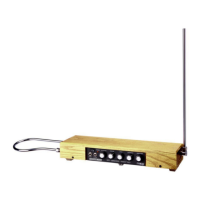
Do you have a question about the Moog Etherwave and is the answer not in the manual?
| Type | Theremin |
|---|---|
| Pitch Range | 5 octaves |
| Audio Outputs | 1/4" audio out |
| Power Supply | External power supply |
| Outputs | 1x 1/4" Audio Out |
| Controls | Waveform |
| Volume Antenna | 3/8" OD plated brass tubing |
Essential steps for setting up the Etherwave theremin, including stand, antennas, and connections.
Guidance on positioning the theremin on a stand or table for optimal performance and clearance.
Instructions for securely mounting the pitch and volume antennas to the instrument.
Details on connecting the power adapter for proper instrument operation and grounding.
How to connect the theremin to various audio systems and recommended input types.
Steps for calibrating the volume and pitch controls for correct instrument response.
Explanation of how hand movements control pitch and volume, and basic performance principles.
Guidance on the optimal physical stance and hand placement relative to the antennas.
Practical exercises to develop essential theremin playing skills like pitch accuracy and dynamics.
Essential care instructions and environmental considerations to ensure instrument longevity.
Highlights additional features of the Etherwave Plus model, such as CV outputs and headphone functions.
Diagram and explanation of the controls and connections on the Etherwave Plus front panel.
Explanations of Control Voltage (CV) and Gate signals used in analog synthesizers and the Etherwave Plus.
Instructions on connecting and utilizing the CV outputs for controlling external equipment.
Practical examples of integrating the Etherwave Plus with other Moog synthesizers and effects.
Steps to modify the headphone output for monitoring pitch independently of the main audio signal.
